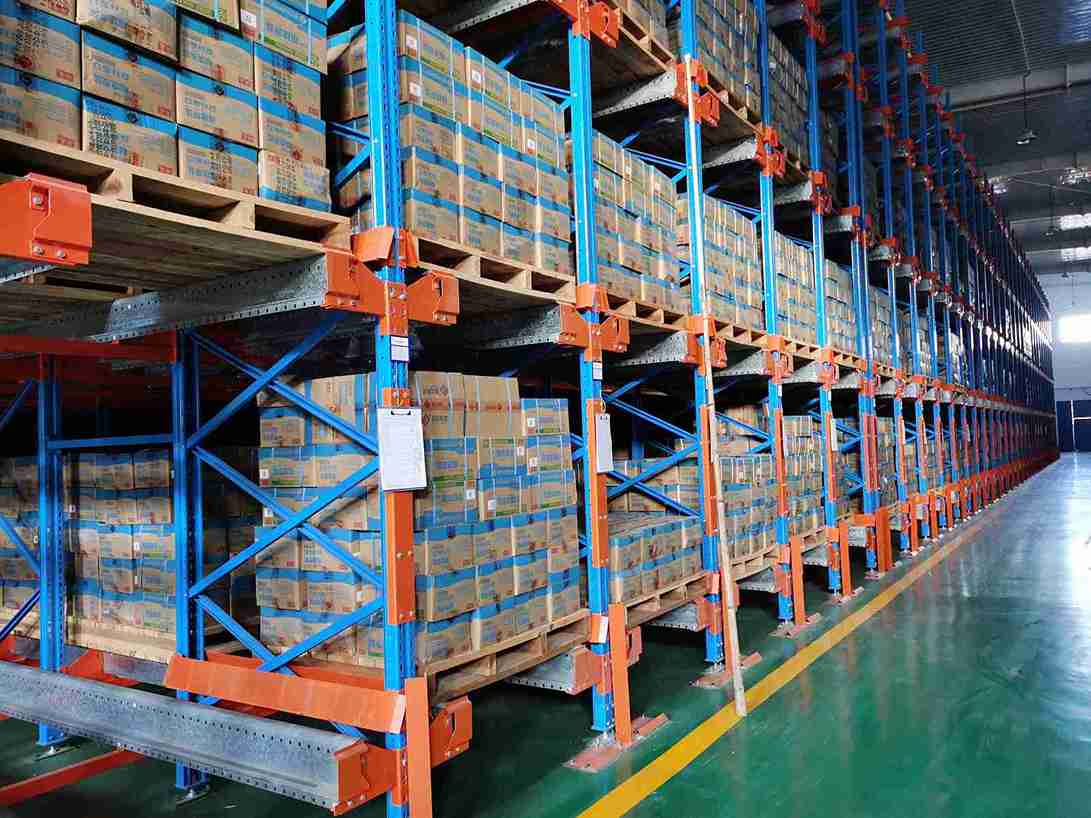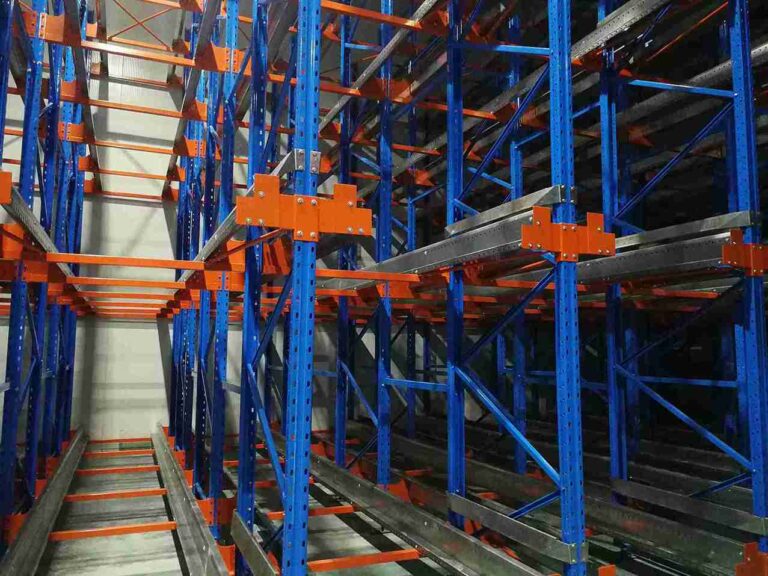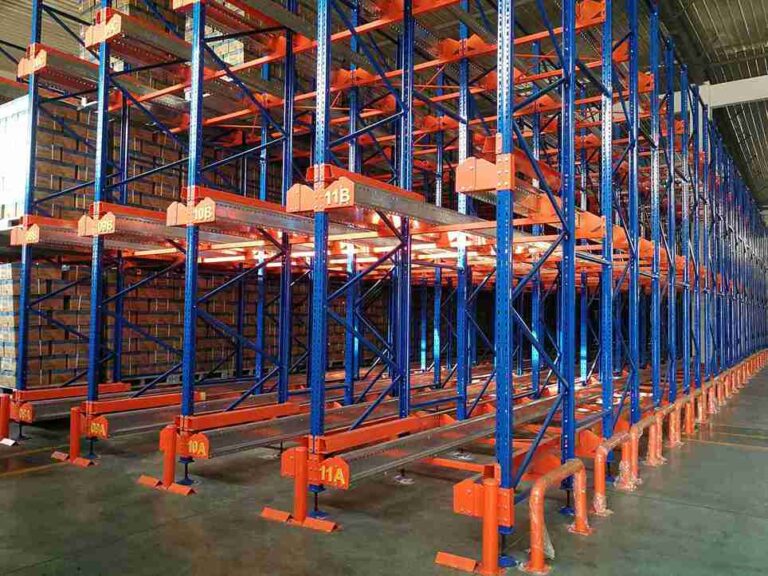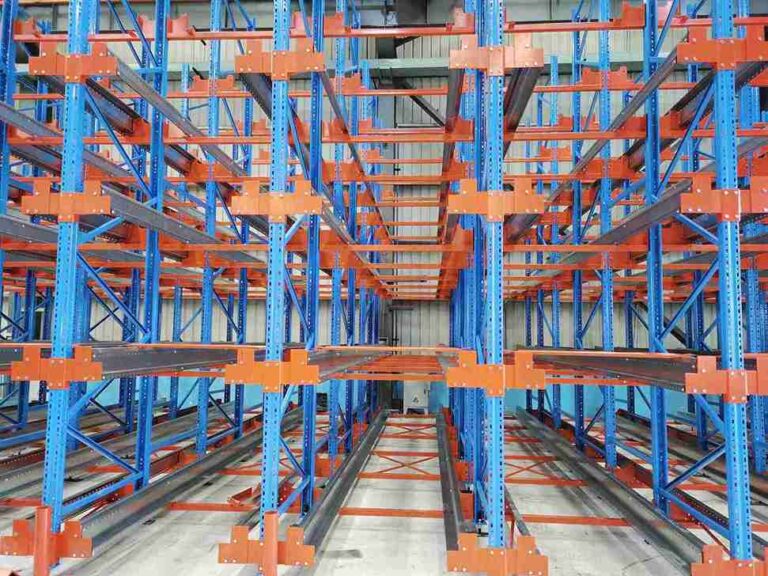📐 "First 50 Enterprise Queries Get Custom 3D Warehouse Design" Plan

In the high-stakes, razor-thin-margin world of third-party logistics (3PL), operational costs—particularly labor costs—represent the most significant and volatile challenge to profitability. The traditional model of relying on large teams for manual picking, forklift operation, and inventory management is becoming economically untenable. For forward-thinking 3PL operators, the strategic implementation of shuttle racking for third-party logistics is no longer a luxury but a fundamental necessity for survival and growth.
This definitive guide delves deep into why shuttle racking for third-party logistics is the cornerstone of modern warehouse optimization, providing a detailed, data-backed roadmap for achieving labor cost reductions exceeding 40%, while simultaneously revolutionizing storage density, accuracy, and scalability.

Shuttle Racking For Third-Party Logistics Profitability Crisis: Unpacking the Unsustainable Labor Burden
Third-party logistics providers are caught in a relentless squeeze. Client demands for faster, cheaper, and more accurate services collide with the operational reality of soaring expenses. The dependency on manual labor creates a precarious business model characterized by:
High Turnover and Training Costs: The physically demanding nature of warehouse work leads to significant staff churn, resulting in continuous, costly recruitment and training cycles.
Inherent Efficiency Ceilings: Human workers, regardless of skill, are limited by fatigue, necessary travel time, and the potential for error, placing a hard cap on productivity.
Peak Season Vulnerability: Managing seasonal spikes requires temporary labor, which is expensive, difficult to source, and often leads to higher error rates and training overheads.
Safety and Compliance Risks: Manual handling and forklift operations present ongoing safety concerns, with potential for accidents that disrupt operations and incur liabilities.
It is within this challenging landscape that the value proposition of shuttle racking for third-party logistics becomes undeniable. This technology is not merely a storage solution; it is a comprehensive operational overhaul. Adopting a robust shuttle racking for third-party logistics system enables a strategic shift away from labor-intensive chaos towards a predictable, automated, and highly efficient workflow, fundamentally altering the cost structure of a 3PL operation.
Shuttle Racking For Third-Party Logistics: The Engine of the Modern 3PL Warehouse
For the uninitiated, an automated shuttle racking for third-party logistics system can be best understood as a fleet of robotic “taxis” operating within a high-density storage structure. The system’s core components include:
High-Density Rack Structure: Unlike traditional selective pallet racking, shuttle racking for third-party logistics is designed for deep-lane storage, holding from 2 to over 10 pallets deep on each side of an aisle, dramatically increasing storage capacity within the same footprint.
Intelligent Shuttle Carriers: These are battery-powered, wireless vehicles that run on rails within the storage lanes. They are responsible for transporting pallets to and from their storage locations upon command.
Lift-and-Transfer Vehicles (Full Automation): In fully automated systems, these vertical lifts transport shuttles between different levels of the rack and interface with conveyor systems or pickup/drop-off points at the aisle ends.
Advanced Control Software: The central nervous system that integrates with the Warehouse Management System (WMS), orchestrating the movements of all components, optimizing task sequences, and ensuring flawless inventory control, including strict FIFO (First-In, First-Out) or FEFO (First-Expiry, First-Out) compliance.
The flexibility of shuttle racking for third-party logistics is a key advantage. Companies can begin with a semi-automated approach, where a forklift places a pallet at the lane entrance for the shuttle to store and retrieve. This serves as an excellent entry point into automation. As business needs evolve and justify further investment, a seamless transition to a fully automated shuttle racking for third-party logistics system is possible, enabling complete hands-off operation from receiving to dispatch.
The Anatomy of a 40%+ Labor Cost Reduction: A Granular Analysis
The claim of reducing labor costs by 40% or more is not hyperbolic; it is a calculated outcome based on the systematic elimination of inefficiencies inherent in manual warehouses.
1. The Radical Reduction in Forklift Dependency and Labor
In a conventional warehouse, forklift operators spend up to 70% of their time traveling rather than performing value-added lifting tasks. A shuttle racking for third-party logistics system internalizes all storage and retrieval movements within the compact rack aisles. The direct result is a drastic reduction in the number of forklifts required and, consequently, fewer highly-paid, certified operators. This single efficiency can account for a 15-25% reduction in the direct labor budget.
2. The Quantum Leap in Order Picking Efficiency
The most transformative aspect of shuttle racking for third-party logistics is the shift from a “person-to-goods” to a “goods-to-person” paradigm. Pallets are delivered automatically to ergonomic pick stations, where operators remain stationary. This yields monumental gains:
300-400% Increase in Picks Per Hour (PPH): The elimination of walking time allows each operator to fulfill orders at an unprecedented rate.
Near-Perfect Order Accuracy: Integrated pick-to-light or put-to-light systems guided by the WMS reduce human error to virtually zero.
Smaller, Highly Effective Picking Teams: Operations can achieve significantly higher throughput with a smaller, more focused workforce, directly reducing labor headcount in the picking department by 25-35%.
3. The Minimization of Indirect and Supervisory Labor
The benefits cascade into less obvious areas:
Automated Inventory Counts: Cycle counting, a major drain on resources, can be performed by the shuttles themselves during off-hours, eliminating the need for labor-intensive, often disruptive, manual counts.
Streamlined Replenishment: Replenishment from reserve to primary picking locations is managed automatically by the system’s software.
Reduced Supervisory Overhead: With a standardized, automated process, the need for constant hands-on supervision diminishes, freeing management to focus on strategic improvement rather than daily firefighting.
When these efficiencies are compounded, a well-engineered shuttle racking for third-party logistics implementation consistently delivers a net reduction in overall labor costs of 40% or more.
Beyond Labor Savings: The Compound Competitive Advantages for 3PLs
While labor cost reduction is the primary driver of ROI, the secondary benefits of deploying shuttle racking for third-party logistics create a powerful virtuous cycle that strengthens the entire enterprise.
An 80-100% Surge in Storage Density and Capacity
By storing pallets in depth and eliminating the wide aisles required for forklift maneuvering, shuttle racking for third-party logistics can typically double storage capacity within the same building envelope. This defers or entirely avoids the colossal capital expenditure of warehouse expansion or relocation, a critical advantage for 3PLs in expensive industrial markets.
Unmatched Scalability and Peak Season Resilience
The ability to handle peak season volumes is a defining competency for any successful 3PL. Manual systems strain and often fail under pressure. An automated shuttle racking for third-party logistics system operates with unwavering consistency 24/7. Its throughput is predictable and can be scaled by optimizing shuttle movement patterns or adding pick stations, providing the agility to confidently accept clients with highly volatile demand.
Perfect Inventory Accuracy and Unbreachable Traceability
Human error in put-away and picking is a major source of financial loss and client dissatisfaction. A shuttle racking for third-party logistics system executes WMS commands with precision, ensuring perfect FIFO/FEFO compliance. Every single pallet movement is logged, creating an immutable audit trail and enabling inventory accuracy rates of 99.9% or higher.
A Safer, More Engaging Work Environment
Minimizing the interaction between personnel and heavy equipment like forklifts dramatically enhances warehouse safety. Furthermore, by automating mundane tasks, companies can upskill their workforce. Employees transition to more rewarding roles in system monitoring, analytics, maintenance, and client management, leading to higher job satisfaction and reduced turnover.
Is Your 3PL Operation an Ideal Candidate? Key Indicators for Shuttle Racking
While powerful, shuttle racking for third-party logistics is not a universal panacea. An operation is likely a prime candidate if several of the following indicators are present:
Chronic labor shortages or unsustainable wage inflation in your region.
Consistently running out of usable storage space.
High SKU count with medium-to-high turnover rates.
Mandated requirements for strict inventory rotation (e.g., food, beverage, pharmaceuticals).
Struggling to meet throughput demands, especially during seasonal peaks.
Persistent issues with inventory accuracy and order fulfillment errors.
Rapid business growth is being hampered by manual system bottlenecks.
A professional feasibility study for shuttle racking for third-party logistics is the logical next step if these challenges sound familiar.
The Implementation Blueprint: A Phased Approach to Success
Deploying a shuttle racking for third-party logistics system is a significant undertaking that thrives on meticulous planning.
Phase 1: In-Depth Data Analysis and Feasibility Modeling
Success is rooted in data. The process begins with a comprehensive analysis of 12-24 months of operational data: SKU velocity, pallet dimensions, inbound/outbound flow profiles, and seasonal trends. This data is used to create a digital twin of the operation, simulating different scenarios to design an optimal shuttle racking for third-party logistics layout tailored to specific business rhythms.
Phase 2: Customized Engineering and Systems Integration
Engineers translate the model into a detailed technical design, specifying the racking, shuttle quantities and types, lift systems, and pick stations. Crucially, this phase involves designing the deep-level integration between the shuttle system’s software and the client’s existing WMS/ERP to ensure seamless data flow.
Phase 3: Phased Installation and Comprehensive Training
To minimize operational disruption, installation is typically executed in phases. Concurrently, a structured training program equips the client’s operations, maintenance, and IT teams with the knowledge to manage and maintain the new shuttle racking for third-party logistics environment effectively.
Phase 4: Go-Live Support and Continuous Optimization
Post-installation, dedicated on-site support ensures a smooth transition. The partnership should evolve into a long-term relationship focused on performance monitoring and continuous improvement through software updates and operational tweaks, maximizing the lifetime value of the shuttle racking for third-party logistics investment.
Calculating the ROI: Building an Irrefutable Business Case
The investment in shuttle racking for third-party logistics is substantial, but the return is tangible and calculable. A thorough ROI analysis must encompass:
Quantifiable Hard Savings:
Annual labor cost reduction (wages, benefits, overtime, temporary agencies).
Real estate cost avoidance (by maximizing existing space).
Reduction in losses from inventory shrinkage and picking errors.
Significant Soft Benefits:
Increased revenue capacity (ability to onboard new clients).
Improved client retention and satisfaction due to superior service levels.
Enhanced brand reputation and competitive advantage during client pitches.
For a medium-to-large 3PL operation, a well-executed shuttle racking for third-party logistics project typically achieves a complete return on investment within a 2 to 4-year period. The financial and operational benefits then continue to compound over the system’s 10-15+ year lifespan.
Building an Ecosystem: Integrating Shuttle Racking with Broader Automation
A shuttle racking for third-party logistics system delivers immense value as a standalone solution, but its potential is maximized when integrated into a broader automation ecosystem. For instance:
Integration with AGVs/AMRs: While the shuttle system handles high-density storage, Autonomous Mobile Robots (AMRs) or Automated Guided Vehicles (AGVs) can manage horizontal transport across the warehouse floor, creating a truly end-to-end automated material flow.
Coupling with Conveyor and Sortation Systems: For piece-picking operations, shuttles deliver totes to workstations, and subsequent sortation is handled by automated systems, streamlining the entire outbound process.
This holistic approach represents the pinnacle of efficiency for a modern third-party logistics provider.
Conclusion: Future-Proofing Your 3PL with Strategic Automation
The central question for 3PL leaders has evolved from if to automate to how and when. The escalating costs and scarcity of labor, combined with unrelenting client expectations, make automation an inevitable strategic destination. Shuttle racking for third-party logistics stands out as the most pragmatic, scalable, and high-impact automation technology for the industry. It directly targets the largest operational cost center while simultaneously boosting capacity, accuracy, and agility.
The journey requires a partnership with an expert who possesses not only technical prowess but also a deep understanding of the unique pressures facing the third-party logistics sector. By embracing a data-driven approach to implementing shuttle racking for third-party logistics, companies can confidently build a more profitable, resilient, and competitive business, fully prepared for the demands of the automated future.
Frequently Asked Questions (FAQs)
1. How does a shuttle system handle varying pallet sizes and weights within a single installation?
Modern shuttle racking for third-party logistics systems are designed for flexibility. The racking can often be adjusted to accommodate different standard pallet sizes (e.g., Euro, GMA). Furthermore, shuttle carriers are available in different load capacities (e.g., 1.5T, 3T). During the critical design phase, a detailed analysis of your inventory profile ensures the system is configured to handle the specific mix of pallet types and weights in your operation.
2. What is the operational impact if a single shuttle car breaks down?
System reliability is a cornerstone of design. In a well-configured shuttle racking for third-party logistics installation, redundancy is key. While a dedicated shuttle failure in a semi-automated lane would halt operations in that specific lane, fully automated systems often feature interchangeable shuttles that can be re-tasked. Additionally, keeping a spare shuttle on-site allows for rapid replacement. The modular nature of the system ensures that a single point of failure does not cripple the entire warehouse.
3. Can we implement a semi-automated system now and upgrade to full automation later?
Absolutely. This phased investment strategy is highly popular and financially prudent for many 3PLs. Starting with a semi-automated shuttle racking for third-party logistics solution in a specific zone (e.g., for fast-moving A-items) delivers immediate benefits. The racking structure is typically future-proof, allowing for a later upgrade to full automation by integrating lift modules and enhanced control software, thereby protecting the initial capital outlay.
4. Is shuttle racking cost-effective for storing very slow-moving (low-turnover) SKUs?
The highest return on investment for shuttle racking for third-party logistics is achieved with medium-to-high turnover inventory. During the design process, an ABC analysis is conducted. It is common and often recommended to store very slow-moving C-items in a separate, more cost-effective storage system (e.g., push-back racking), while the shuttle system is optimized for the inventory that drives the majority of your activity. This hybrid approach maximizes the overall efficiency and ROI of the warehouse.
5. What does the ongoing maintenance and support structure for a shuttle system entail?
A comprehensive shuttle racking for third-party logistics solution includes a robust service level agreement (SLA). This involves scheduled preventive maintenance visits for inspections, software updates, and wear-part replacement. Remote monitoring capabilities often allow for proactive issue detection. Client teams are trained to handle basic operational checks, while the supplier’s specialist technicians manage more complex repairs, ensuring maximum system uptime and longevity.
Welcome to contact us, if you need warehouse rack CAD drawings. We can provide you with warehouse rack planning and design for free. Our email address is: jili@geelyracks.com




